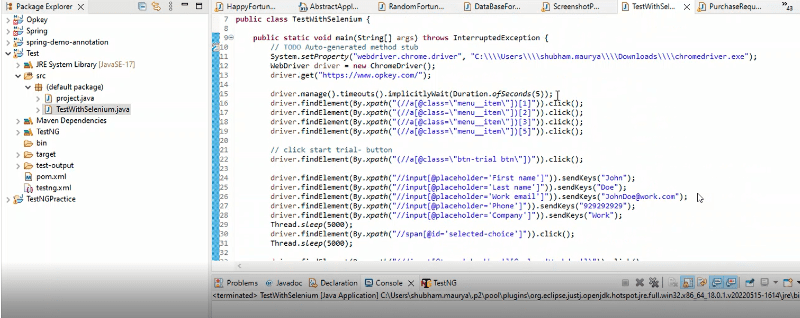Selenium, a popular open source tool for test automation, is often an organization’s first choice once they decide to move away from monotonous manual testing. However, Selenium isn’t built for Oracle Cloud.
And testing Oracle Cloud apps with Selenium can often be more cumbersome than doing so manually.
In this blog, we’ll explain why Selenium for Oracle testing isn’t an intelligent choice and will explain how Opkey’s Oracle-aware platform was built for Oracle testing.
Now let’s jump in.
How Does Selenium Work?
Selenium uses web element properties like ID, name, class, XPath, Tagname, or CSS to identify a control on a web page and to perform actions on it. If the properties of elements don’t change in your application, Selenium can easily identify the controls and offer stable test results.
This is where Selenium works best.
Unfortunately, Oracle Cloud elements are dynamic…
Why Oracle Cloud Applications Present a Unique Struggle for Selenium
-
Oracle Cloud applications have dynamic user interfaces and don’t have fixed attributes like ID, Name, Class, or CSS.
- Since Oracle Cloud apps don’t have these fixed attributes, it’s technically challenging to locate them using Selenium. Furthermore, any changes to the applications’ UI can break Selenium scripts.
-
Most Oracle Cloud apps have security restrictions in place, such as two-factor authentication.
- It’s extremely technically complex to work in security elements into Selenium tests
-
Oracle Cloud apps contain many complicated web elements like iframes, popups and menus.
- These are not easy to code for in Selenium, and make it hard to create stable tests
-
Oracle Cloud apps are updated quarterly. Every time after a release, functional and technical analysis must be performed to understand the impact on the environment.
- Because of these quarterly updates–where major changes occur–Selenium tests are also difficult to maintain.
-
Oracle Cloud applications are usually integrated heavily with third-party applications.
- This makes it difficult to perform end-to-end testing across the total application ecosystem using Selenium due to technical complexity and incompatibility with Java applet technology (Oracle forms)
-
Most Oracle Cloud apps have security restrictions in place, such as two-factor authentication.
- It’s extremely technically complex to work in security elements into Selenium tests
How Opkey’s Intelligent No-Code Solution Solves for These Challenges
Low learning curve:
No-code Oracle testing platforms like Opkey empower non-technical employees to create and scale automation without coding knowledge.
Automated tests can be created using an easy drag-and-drop test builder with pre-built test components. Alternatively, users can simply go through their regular workflows while recording their actions and creating automated tests.
Furthermore, Opkey comes with more than 5,000+ pre-built, Oracle Cloud tests that customers can use from day 1.
Here’s what a test automation flow in Opkey looks like.

Compare this to Oracle testing with Selenium, where an immense amount of coding skills are required.
Since it’s extremely difficult to find employees who have both Oracle functional knowledge and Selenium coding knowledge, organizations often end up having a joint team of coding experts and Oracle Functional Experts when they use Selenium.
And of course, more people means more money dedicated to testing.
It’s complicated! Here’s what a Selenium test looks like.

Ease of maintenance:
Opkey’s platform can easily handle dynamic web elements and dynamic user interfaces, which are both challenges for Selenium.
Furthermore, Opkey is built for Oracle’s quarterly updates. With our Impact Analysis reports, customers can quickly see which tests will be impacted by updates, and with self-healing technology, customers can fix broken tests without human intervention.
Opkey customers spend 80% less time on test maintenance than their Selenium-using counterparts.
True end-to-end testing:
Opkey supports more than 12 packaged applications and 150 technologies, including the industry’s most popular test management, DevOps, and CI/CD tools.
Selenium isn’t exactly a one-stop remedy. You’ll need to either design your own system using a script or incorporate another piece of software in order to create reporting and monitoring features.
Scientifically know what to test:
Opkey can plug into your Oracle Cloud environment to discover the historical tests you’ve executed. In parallel, Opkey uses process mining technology to uncover the business processes your employees are running, along with their most common deviations.
With this information, Opkey highlights gaps in your test coverage, and recommends tests to fill those gaps.
Selenium has none of these capabilities.
Choosing the right automation tool for the right skill set is often the difference between success and failure for ERPs.
We hope this blog helps convince you that Opkey is the clear choice for testing Oracle Cloud, over Selenium.

Frequently asked questions:
Frequently Asked Questions
Selenium is an open-source tool that is specifically used to test web elements. To recognize dynamic controls on the screen and trigger actions, Selenium uses element characteristics including ID, Class, XPath, Tag Name, and CSS Selector. The same fixed properties cannot be used to automate Oracle forms. This means that tests can become unstable and flaky even with just minor UI changes. Therefore, despite automated testing, there is still a considerable business continuity risk.
In order to use Selenium ide, you must first identify the web components, then add actions in your chosen programming language along with the test data, and then run tests.
The initial steps in setting up Selenium include:
- Installing a library
- Installing browser drivers
- Opening and closing a browser with Selenium
- Writing your first script
You need a lot of technical skills and time to integrate third party test management tools into Selenium. Either create your own system using scripts or include another piece of software to create reporting and monitoring features.





